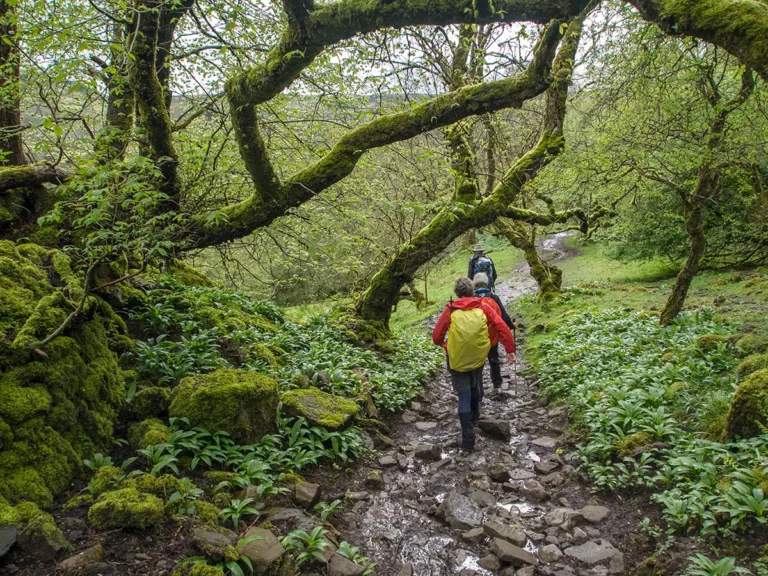Along your hiking journey, you’ll see three trail types consistently. These are out-and-back, point-to-point, and circular or loop trails.
Out-and-back trails are one way in, one way out, guiding you to the end-point and returning to the starting point on the same path. They are also the most common type of hiking trail.
Often, an out-and-back hiking trail leads to scenic views or monuments. Angels Landing Trail in Zion National Park is one of the most popular out-and-back hiking trails in the U.S., leading to spectacular 360-degree views of the valley.
This article explains the benefits of hiking an out-and-back trail and how they compare to additional trail types.
What is an out-and-back trail?
One of my most demanding hikes was turning an out-and-back trail into a partially off-trail lollipop loop after meeting a younger, very skilled backpacker along the way. He was a friendly kid and offered us to join him on a shortcut to spectacular views while hiking the Bridge Mountain Trail to the North Peak Trail in Red Rock Canyon.
Both trails are already challenging, and his sheer climb up a steep mountain almost ended my love for hiking. He was right about the view; the photo in my avatar is from the top. But, after a few wrong turns to find the trailhead and return, the hike extended from an anticipated 10 miles to almost 15 miles.
Had we stayed on the out-and-back trail, the panoramic views of Red Rock and the Las Vegas Valley would have still been spectacular, the distance would be predictable, and the challenge known.
What are the benefits of an out-and-back trail?
Consider out-and-back trails as a journey to a beautiful site. There’s no question that the scenery along the way will be stunning, but the end of the trailhead typically makes the voyage.
Here are some of the most majestic destinations for out-and-back hikes in the U.S.:





Aside from the memorable ending, there are several benefits to out-and-back hiking trails, such as:
- Ease of navigation: With one trail in and out, remaining on the path to find your way back is simple. Winding trails with forks and side trails can be disorienting, especially for beginner hikers.
- Predictability: After reaching the trail end, you clearly understand your trek back. Now, you can rest and recover, knowing the time needed for the return hike.
- Well traveled: Expect to cross paths with returning hikers along popular out-and-back trails. Because of this, you can ask fellow hikers how much further, the difficulty of the final stretch, and any tips when you reach the end.
I’ve always tested new hiking boots on out-and-back trails since they are usually easy, and when facing problems, I know the challenges I encounter on the hike back.
What’s the difference between an out-and-back trail and other trail types?
Although there are three typical trails, loop, out-and-back, and point-to-point, there are also hybrids. Here are common hiking trail types besides out-and-back:
Loop trail: When hiking a loop trail, you remain on the same trail from start to finish, never retracing your steps. Loop trails typically end close to or at the starting point but don’t share the path back. Loop trails are often scenic throughout, and many don’t have the spectacular ending of an out-and-back.
Lollipop trail: A type of loop trail, the lollipop trail is a hybrid between an out-and-back trail and a loop. Lollipops start and finish on the same trail after taking a loop at the end trail.
Point-to-point trail: Usually reserved for long-distance hikes like the Appalachian trail, a point-to-point hike ends in an entirely different location than the start. These hikes take extra planning since you’ll need transportation to or from a point.
Thru-hiking trails: A type of point-to-point trail, thru-hiking trails typically take days, weeks, or months to complete.
Side trail: Side trails are shorter branches off a more extensive trail. Often leading to a viewpoint, waterfall, or historic site.
Tips for hiking an out-and-back trail
Although out-and-back trails are often less challenging, the hiking basics remain. To prepare for your out-and-back hike, follow these steps:
- Research the trail: It’s vital to know the distance of your out-and-back route, the difficulty, the type of terrain, and the elevation change. A 3-mile hike can take an hour, or six. If the trail is in a national park, utilize NPS.gov or visit sites like Alltrails.
- Wear appropriate footwear: Wearing cross-trainers on hikes with high elevation change and rocky terrain isn’t advised. But flat, well-paved trails don’t always require hiking boots.
- Bring enough water: A general rule of hiking is to drink one half-liter of water per hour. Always consider temperature, difficulty, and fitness level when determining how much water to bring on hikes; it’s always better to have extra water.
- Bring electrolyte-replenishing snacks: Trail mix and beef jerky can help you stay hydrated by replenishing your electrolyte levels. A snack at the trail end can provide the energy needed for the hike back.
Final thoughts
I prefer out-and-back trails. I’m a sucker for breathtaking views and a lover of waterfalls. But, sometimes, I need a long walk on a beautiful loop trail.
As you begin to travel to hiking destinations, a loop trail through a moss-covered forest might far exceed the trail end of an out-and-back.
Discovering what drives you when hiking, that “it” factor that encourages you to push through challenging sections and overcome exhaustion, is the drive you need to continue your hiking journey.
If you enjoy putting in hard work for a spectacular outcome, you’ll quickly fall in love with out-and-back hiking trails.
What out-and-back hiking trail are you conquering next? Share this article on your socials and let us know!








